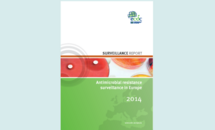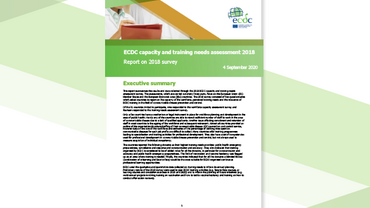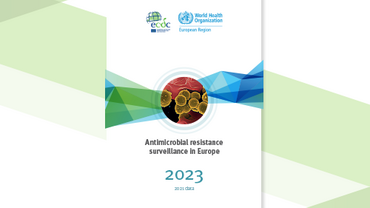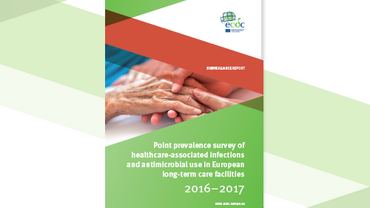Antimicrobial resistance surveillance in Europe 2014
This report presents antimicrobial resistance data for seven microorganisms of major public health importance: Escherichia coli, Klebsiella pneumoniae, Pseudomonas aeruginosa, Acinetobacter species, Streptococcus pneumoniae, Staphylococcus aureus, and Enterococci. For 2014, data were reported by 29 countries and the report also presents trend analyses for the period 2011–2014.
Download

Publication data
Data
Total number of tested isolates* and resistance combinations among invasive isolates tested against aminopenicillins, third-generation cephalosporins, fluoroquinolones, aminoglycosides and carbapenems (n=52 788), EU/EEA countries, 2014
* Only data from isolates tested against all five antimicrobial groups were included in the analysis.
Data
Number of laboratories reporting isolates resistant to third-generation cephalosporins (3GCREC)
Number of laboratories reporting isolates resistant to third-generation cephalosporins (3GCREC), numbers of 3GCREC isolates identified and percentage of isolates positive for extended-spectrum beta-lactamase (ESBL), as ascertained by the participating laboratories, EU/EEA countries, 2014
Data
Number of laboratories reporting isolates resistant to third-generation cephalosporins (3GCREC)
Number of laboratories reporting isolates resistant to third-generation cephalosporins (3GCREC), numbers of 3GCREC isolates identified and percentage of isolates positive for extended-spectrum beta-lactamase (ESBL), as ascertained by the participating laboratories, EU/EEA countries, 2014
Data
Total number of tested invasive isolates* and resistance combinations against third-generation cephalosporins, fluoroquinolones, aminoglycosides and carbapenems (n=18 180), EU/EEA countries, 2014
* Not adjusted for population differences in reporting countries
Data
Number of laboratories reporting isolates resistant to third generation cephalosporins (3GCRKP)
Number of laboratories reporting isolates resistant to third generation cephalosporins (3GCRKP), numbers of 3GCRKP isolates identified and percentage of isolates positive for extended-spectrum beta-lactamase (ESBL), as ascertained by the participating laboratories, EU/EEA countries, 2014
Data
Number of laboratories reporting isolates resistant to third generation cephalosporins (3GCRKP)
Number of laboratories reporting isolates resistant to third generation cephalosporins (3GCRKP), numbers of 3GCRKP isolates identified and percentage of isolates positive for extended-spectrum beta-lactamase (ESBL), as ascertained by the participating laboratories, EU/EEA countries, 2014
Data
Total number of invasive isolates tested (N) with combined resistance
Total number of invasive isolates tested (N) with combined resistance (resistance to three or more antimicrobial groups among piperacillin(+tazobactam), ceftazidime, fluoroquinolones, aminoglycosides and carbapenems) including 95% confidence intervals (95% CI), by country, EU/EEA countries, 2011-2014
Data
Total number of invasive isolates tested (N) with combined resistance
Total number of invasive isolates tested (N) with combined resistance (resistance to three or more antimicrobial groups among piperacillin(+tazobactam), ceftazidime, fluoroquinolones, aminoglycosides and carbapenems) including 95% confidence intervals (95% CI), by country, EU/EEA countries, 2011-2014
Data
Total number of invasive isolates tested (N) and percentage resistant to aminoglycosides (%R)
Total number of invasive isolates tested (N) and percentage resistant to aminoglycosides (%R), including 95% confidence intervals (95% CI), EU/EEA countries, 2011-2014
Data
Total number of invasive isolates tested (N) and percentage resistant to aminoglycosides (%R)
Total number of invasive isolates tested (N) and percentage resistant to aminoglycosides (%R), including 95% confidence intervals (95% CI), EU/EEA countries, 2011-2014
Data
Total number of invasive isolates tested (N) and percentage resistant to carbapenems (%R)
Total number of invasive isolates tested (N) and percentage resistant to carbapenems (%R), including 95% confidence intervals (95% CI), EU/EEA countries, 2011-2014
Data
Total number of invasive isolates tested (N) and percentage resistant to carbapenems (%R)
Total number of invasive isolates tested (N) and percentage resistant to carbapenems (%R), including 95% confidence intervals (95% CI), EU/EEA countries, 2011-2014
Data
Total number of invasive isolates tested (N) and percentage resistant to ceftazidime (%R)
Total number of invasive isolates tested (N) and percentage resistant to ceftazidime (%R), including 95% confidence intervals (95% CI), EU/EEA countries, 2011-2014
Data
Total number of invasive isolates tested (N) and percentage resistant to ceftazidime (%R)
Total number of invasive isolates tested (N) and percentage resistant to ceftazidime (%R), including 95% confidence intervals (95% CI), EU/EEA countries, 2011-2014
Data
Total number of invasive isolates tested (N) and percentage resistant to fluoroquinolones (%R)
Total number of invasive isolates tested (N) and percentage resistant to fluoroquinolones (%R), including 95% confidence intervals (95% CI), EU/EEA countries, 2011-2014
Data
Total number of invasive isolates tested (N) and percentage resistant to fluoroquinolones (%R)
Total number of invasive isolates tested (N) and percentage resistant to fluoroquinolones (%R), including 95% confidence intervals (95% CI), EU/EEA countries, 2011-2014
Data
Total number of invasive isolates tested (N) and percentage resistant to piperacillin+tazobactam (%R
Total number of invasive isolates tested (N) and percentage resistant to piperacillin+tazobactam (%R), including 95% confidence intervals (95%CI), EU/EEA countries, 2011-2014
Data
Total number of invasive isolates tested (N) and percentage resistant to piperacillin+tazobactam (%R)
Total number of invasive isolates tested (N) and percentage resistant to piperacillin+tazobactam (%R), including 95% confidence intervals (95%CI), EU/EEA countries, 2011-2014
Data
Total number of tested isolates and resistance combinations among invasive isolates
Total number of tested isolates and resistance combinations among invasive isolates tested against at least three antimicrobial groups among piperacillin±tazobactam, ceftazidime, fluoroquinolones, aminoglycosides and carbapenems (n=11 649 ), EU/EEA countries, 2014
Data
Total number of tested isolates and resistance combinations among invasive isolates
Total number of tested isolates and resistance combinations among invasive isolates tested against at least three antimicrobial groups among piperacillin±tazobactam, ceftazidime, fluoroquinolones, aminoglycosides and carbapenems (n=11 649 ), EU/EEA countries, 2014
Data
Total number of invasive isolates tested (N) and percentage resistant to aminoglycosides (%R)
Total number of invasive isolates tested (N) and percentage resistant to aminoglycosides (%R), including 95% confidence intervals (95% CI), EU/EEA countries, 2012-2014
Data
Total number of invasive isolates tested (N) and percentage resistant to aminoglycosides (%R)
Total number of invasive isolates tested (N) and percentage resistant to aminoglycosides (%R), including 95% confidence intervals (95% CI), EU/EEA countries, 2012-2014
Data
Total number of invasive isolates tested (N) and percentage resistant to carbapenems (%R)
Total number of invasive isolates tested (N) and percentage resistant to carbapenems (%R), including 95% confidence intervals (95% CI), EU/EEA countries, 2012-2013
Data
Total number of invasive isolates tested (N) and percentage resistant to carbapenems (%R)
Total number of invasive isolates tested (N) and percentage resistant to carbapenems (%R), including 95% confidence intervals (95% CI), EU/EEA countries, 2012-2013
Data
Total number of invasive isolates tested (N) and percentage resistant to fluoroquinolones (%R)
Total number of invasive isolates tested (N) and percentage resistant to fluoroquinolones (%R), including 95% confidence intervals (95% CI), EU/EEA countries, 2012-2014
Data
Total number of invasive isolates tested (N) and percentage resistant to fluoroquinolones (%R)
Total number of invasive isolates tested (N) and percentage resistant to fluoroquinolones (%R), including 95% confidence intervals (95% CI), EU/EEA countries, 2012-2014






